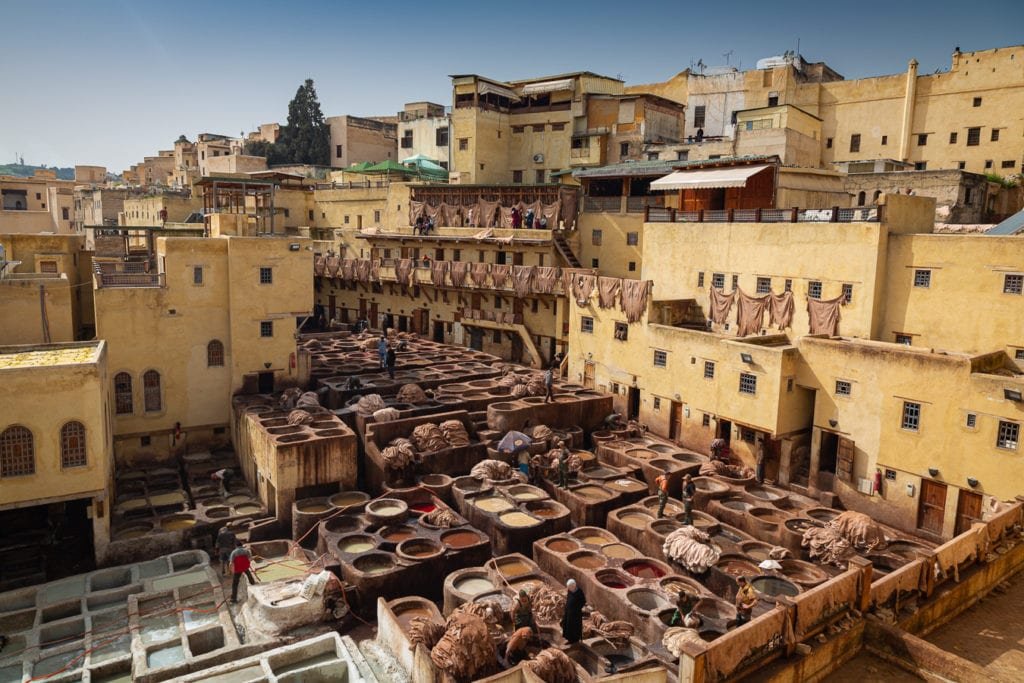How to visit the tanneries of Fez, Morocco
Step back in time to witness a unique process that has largely remained unchanged for over 1000 years. A visit to the tanneries of Fez, Morocco gives an unparalleled glimpse into the ancient system of treating leather. There are actually three tanneries in this UNESCO World Heritage Site, Chouara being the most popular. No visit to the Medina of Fez is complete without visiting at least one of them. Here’s what to expect.
Getting there
Finding the tanneries can be a little tricky because it requires navigating an enormous maze that is also known as the medina. Kiss your GPS and Google Maps good-bye because they won’t be much help here. A pre-arranged guided tour is an option. Someone will meet you at your hotel or hostel and take you to one or more of the tanneries. A guided tour usually will include a visit to other notable parts of the medina. If you are short on time or don’t fancy the adventure of getting lost for hours while exploring the many shops and stalls then this might be your top choice. Another possibility is to ask someone for directions, chances are though that the person you ask will just take you straight there but with the undisclosed expectation of receiving a tip after they deliver you to a tannery. In all honesty, this isn’t a bad way to go. Don’t be put off by the overly assertive assumption that you should give a “tip.” Think of it more as payment for a service, not as being duped by a seemingly selfless gesture. The tip amount is usually 10-20 Dh – that’s about 1-2 US dollars so it’s not like you’re breaking the bank or anything. A third option is to bump and fumble your way using a combination of good directional instincts, confusing map directions, following the strong odor of the tanneries, and sheer luck.
How to view the tanning process
Now that you’ve gotten to the tannery the next step is to go up top to a viewing terrace so you can get a bird’s eye view of the entire process. In order to do that you enter through one of the many leather shops that surround the tannery. It is free to enter the shops but there is the expectation that you will buy something. The guide that brought you here might even get a cut of what you purchase as a sort of commission for bringing you to this particular shop. It’s part of the way things are done in Morocco. (Don’t worry about it too much. It’s just helpful to be in the know of how their side of the business is done.) The shop owners are happy and even eager to let you view the process from their viewing terrace. Many will even explain the steps in the tanning practice. As you leave expect to be bombarded with pushy salesmen. They want to show you a vast array of leather goods. A purse, a clutch, a jacket, a poof, shoes, if it comes in leather then you are guaranteed to be able to find it here.
Author’s tip: Before you first enter one of the leather shops there are people outside with sprigs of mint that they will sell to you. Buy one. You hold it under your nose while you are on the viewing terrace to help with the smell.
Get to know the tanning process
Spread out like a tray of watercolors are giant vats holding the multi-colored liquids that are needed to tan the hides. Also inside the vats are the men who use the stomping power of their feet to make the hides soft and pliable and able to take the dye.
The first soak in the process: Urine. Yup. The hides are first soaked in a mixture of cow urine, quicklime, water and salt. It helps break down the hide and loosen excess fat, flesh and hair (I know, gross).
The second soak in the process: Poop. Pigeon poop and water to be exact. The ammonia in the poop helps soften the hides to prepare them for dyeing. (Gross again, right?)
The third soak in the process: Dye! The hides are placed in vessels that contain natural vegetable dyes such as poppy flowers for red leather, indigo for blue, mint for green, and the most expensive is saffron to get yellow.
After the leather is ready, it is laid out flat on a rooftop to dry. From there it goes to the many merchants and shoemakers who turn it into the artisan goods available throughout the country and beyond.
This process is very natural and hasn’t changed much over the centuries. After a visit to one of the tanneries you will come away with a new appreciation of this ancient process and the artisans who keep the practice alive today.

